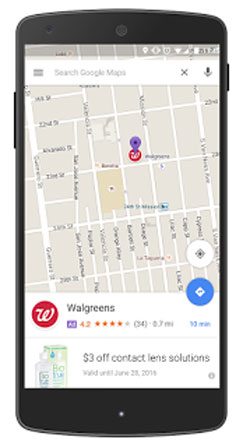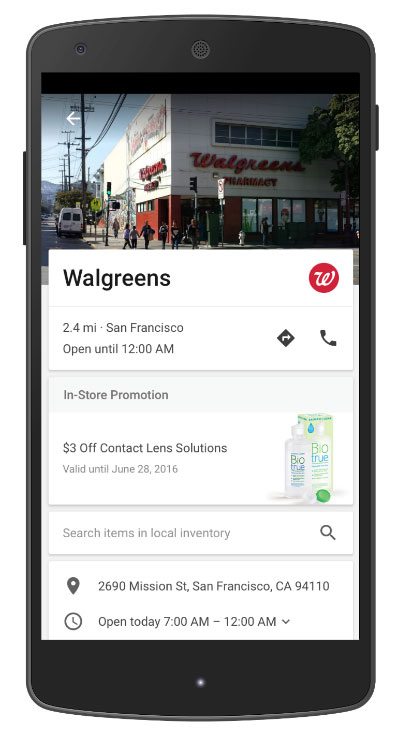Google Promoted Pins Officially Moves From Alpha to Beta
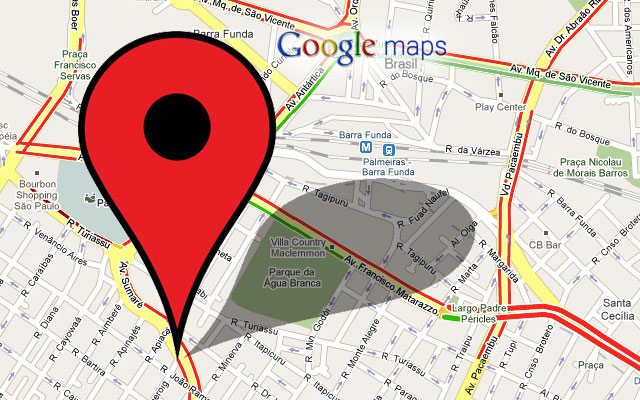
Google is finally launching a pilot for Promoted Pins within the maps application. This has been a hot topic since it was first announced at the Google Performance Summit, and is now officially moving from alpha to beta. Here’s a closer look at how the pins function and what they mean for big brands in the future.
What Are Promoted and Branded Pins?
Promoted pins: Promoted pins enable advertisers to increase the number of impressions their business receives on Google Maps. Without promoted pins, only a limited number of locations are surfaced organically and they may not be the ones closest to the user (other factors such as popularity are also considered). Promoted pins give advertisers the chance to engage consumers even if they are not actively searching, driving increased awareness of a business, as well as in-store traffic.
Branded pins: Branded pins enable advertisers to replace generic pins on the map with a circular version of their logo, increasing brand awareness around business locations and capturing more user attention. Branded pins are eligible to show as organic result as well (“platform buy”). Branded pins enhance the value for advertisers by making pins more prominent and drive additional brand value.
How They Work for Consumers
Local: User is at home or in a familiar neighborhood and is exploring the area on Google Maps. The user will see pins on the basemap that are highly relevant.
Traveling Within Local Area: User is planning on visiting a different part of town, e.g. going from Lower East Side in Manhattan to The Metropolitan Museum and it’ll be about lunch time when reaching the Met. The user will see targeted pins (e.g., cafes / restaurants based on user preference, search history, location history, etc.) when exploring the area around the Met.
In a New Town/Unfamiliar Location: User is traveling and visiting a new country or city / town. When exploring Google Maps, the user will see pins in categories of interest to the user.
What Are The Implications?
With queries of local intent composing nearly a third of mobile search, it’s only natural that Google is bringing a paid model to the Maps platform. It’s a given that advertisers utilizing location extensions will inherit the ability to leverage Promoted Pins in their campaigns, however, it’s unclear at this point how it will be rolled out within the AdWords UI. Likewise, Google has not yet mapped out how this may have an impact on Google My Business action data within the GMB interface.
Based on other existing extension features, Pins should receive some control functions around ad scheduling, as it will be more effective to display the ad units only when a location is open for business. Additionally, it’s likely an option to toggle what devices Pins can be shown on will be baked in.
This Looks Familiar
This initiative is very similar if not identical to a Sponsored Map Icons beta tested by Google back in 2010:
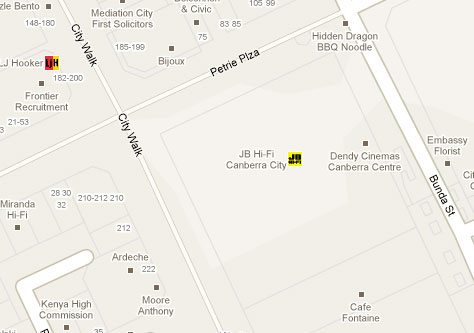
*Brands shown are examples only and are not associated to data referenced.
Some of the issues we saw with the 2010 version were that the brands icons only displayed at a user zoom level of 16X or higher, which I’m sure will not be a problem with the new Promoted Pins initiative.
Another finding from testing in 2010 was that the pins were truly a display initiative, while we were wanting more clicks and site traffic to be driven via the sponsored pins that was not the case. During that beta testing, we saw around 150,000 impressions per day per brand tested for all of their locations, and that dropped to around 100,000 impressions per day on the weekends.
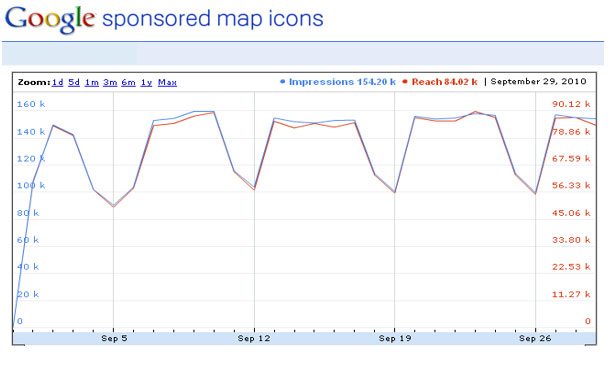 With Waze functionality now tying into Google Maps, better traffic and user analytics forthcoming via Google’s acquisition of Urban Engines, and maps usage now at over 1 billion monthly users, the impression numbers will be much higher this time around, and those impressions should be much more valuable as well, assuming a similar CPM ($5) as it was 6 years ago.
With Waze functionality now tying into Google Maps, better traffic and user analytics forthcoming via Google’s acquisition of Urban Engines, and maps usage now at over 1 billion monthly users, the impression numbers will be much higher this time around, and those impressions should be much more valuable as well, assuming a similar CPM ($5) as it was 6 years ago.
What To Do Next
Although this has been the talk of the local industry, it will likely only be a fit for bigger brands with discretionary budget for brand awareness efforts. So all of the franchise systems and multi-unit brands looking to drive trackable, in-store conversions might want to wait this one out until the Starbucks of the world test it and help to work out the valuation and capabilities for measuring any real in-store lift.
Campaigns will likely start appearing in live map results sometime prior to December, and at that time, we will know a lot more about how results are being tracked and performance valued.
This new Promoted Pins ad format will come with a hefty price tag, estimated at $30,000 to $50,000 a month in display spend, so gauging performance effectiveness will all be dependent upon how good the user behavior can be measured. If we can see in-store visits tied in through GMB Insights, and track conversions, then Promoted Pins will prove out huge value; if not, it will be a branding initiative that gets evaluated amongst all the other brand awareness initiatives your brand has to choose from. The fact that it’s on Google Maps and has 1 billion eyes a month on it will likely rank this a bit higher on the display opportunities checklist when it comes to making budget allocation decisions.
My hope is that there will be real user engagement metrics tied to performance reporting if not for any other reason than I don’t believe Google would try this again had it not taken it to the level of Offline to Online validation. Let’s find out!
A special thanks to Tom Lynch, Nick Neels and Jim Halligan for collaboration on this post.
Stay In Touch.
Subscribe to our monthly email newsletter.

